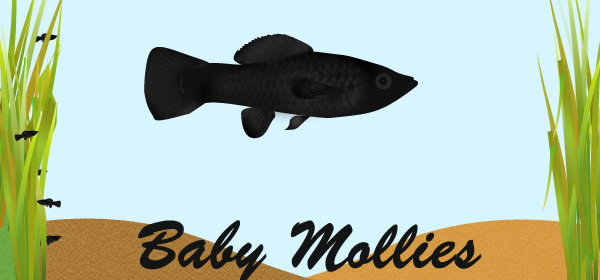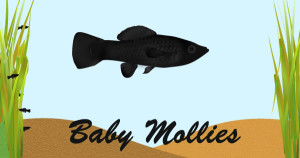Baby Mollies


Babies are lovely!
How to care for your newborn Baby Mollies
You got baby mollies! Good job! Everybody loves baby mollies. They are fun to watch and gives more life to your aquarium. But what to do with baby mollies? How to feed them? Here’s some basic information and tips to get you started.
Tank
The pregnant molly is supposed to be isolated into a separate tank to nurse it either in suspended net or in a birth box.This means the babies are suppose to be separate from the other fully grown fish. Immediately the mother gives birth should be taken out not to eat his babies thinking they are food. The babies tank should have temperatures of between 78 and 80 and need a pH which is neutral and stable raging between 7 and 8. Baby mollies survive well in a spacious aquarium. They are known for utilization of space and its high mobility hence at least a 20 gallon tank wound be ideal for the baby mollies. The aquarium for baby mollies should have adequate supply of oxygen to ensure they do not suffocate and die. Finally, decorations of any kind do not disturb their quite life but adds flavor to their playful life.
Protection
As mentioned earlier the worst enemy of baby mollies is their mother since she eats them if not separated from her own fish babies.Due so such a danger their several methods used to curb that problem.They are highlighted briefly below.
- Its important to use natural or artificial plants to offer them hiding grounds for them in case of any danger they face from their ‘cannibal mother’. Its highly recommended such plants have leaves floating on the surface of water. Many of fish farmers also feel its to an added advantage to have feathery plants increasing the surface for hiding.
- One can use an industrial made “breeder box
” which has separated chambers for the mother and baby mollies. Its placed on top of the tank and ensures when the molly babies are born they move to the next chamber and hide from their mother. The size of the mother keeps her at bay and the baby mollies are safe.
Feeding
The baby mollies are in very critical stage of the life of the entire molly fish generation. They undergo rapid cell division, elongation and enlargement hence they should be fed on regular basis.
Their favorite base food for the babies is flake food. its highly nutritious and ideal for easy growth and development at very fast rate.The flake food however should crushed into very fine pellets to easy swallowing by the baby mollies.They are ,like grown up mollies, have huge appetite for meat food like small worms like black worms.They also feed on vegetables and algae so it would be prudent to add to their diet to supplement flakes and meaty food.
Tank mates
Its not advisable to breed molly fish babies and other varieties since they are said to, like the adult mollies, have a sharp fin which can injure others. Otherwise, they are very friendly and can co-exist with other types of fish in the same tank harmoniously.
Caring for molly fish fry (baby fish) requires some special attention and care. Here are some tips for caring for molly fish fry:
Keep the water clean: It is important to keep the water clean and well-filtered, as dirty water can lead to illness and death in the fry. You should perform regular water changes and use a good quality filter to maintain good water quality.
-
Provide a suitable diet: Molly fry will need a diet rich in nutrients to help them grow and develop. This can include baby brine shrimp, crushed flakes, or a commercial fry food. It is important to feed the fry small amounts several times a day, as they have small stomachs and cannot eat a lot at once.
-
Use a breeding box or separate tank: It is a good idea to use a breeding box or separate tank for the fry, as this will allow you to better control the water conditions and provide the fry with a safe, stress-free environment.
-
Protect the fry from predators: Fry are vulnerable to being eaten by larger fish, so it is important to protect them from predators. This may involve using a fine-mesh net to separate the fry from the adult fish, or using a separate tank or breeding box.
-
Gradually introduce the fry to the main tank: Once the fry are large enough and able to fend for themselves, you can gradually introduce them to the main tank. It is a good idea to do this slowly, by adding a few fry at a time over the course of a few days. This will help to prevent the fry from being overwhelmed or stressed by the larger fish.
By following these general guidelines and paying attention to the needs of your molly fry, you can help them grow and thrive in your home aquarium.
